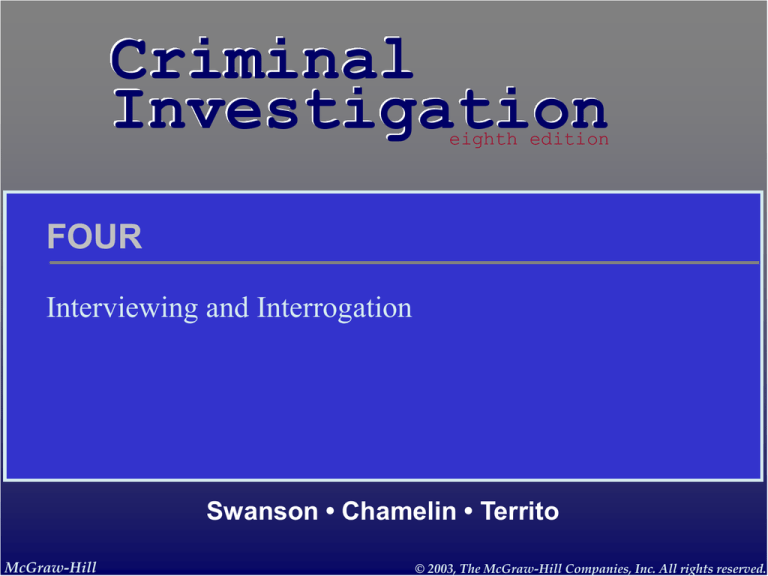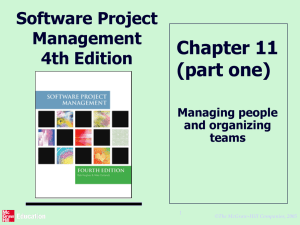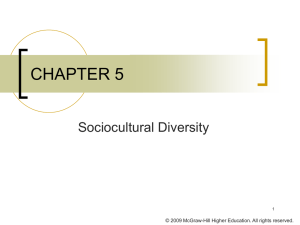
Criminal
Investigation
eighth edition
FOUR
Interviewing and Interrogation
Swanson • Chamelin • Territo
McGraw-Hill
© 2003, The McGraw-Hill Companies, Inc. All rights reserved.
LEARNING OBJECTIVES
• Understand the differences and similarities between
interviews and interrogation
• Outline the steps in preparing for an interview and an
interrogation
• Assess the challenges in relying on eyewitness
identification
• Explain the role of hypnosis in criminal investigation
• Describe Neuro-Linguistic Programming (NLP)
• Identify interviewing processes and techniques
• Explain the impact of Miranda v. Arizona and other
landmark Supreme Court cases on police interrogation
• Identify interrogation processes and techniques
• Understand the methods and importance of documenting
an interview and interrogation
• Explain the importance of listening in an interview and
interrogation
McGraw-Hill
4-1
© 2003, The McGraw-Hill Companies, Inc. All rights reserved.
OBJECTIVES OF THE INTERROGATION PROCESS
• Successful interrogation accomplishes four
objectives:
–
–
–
–
McGraw-Hill
Obtaining facts
Eliminating the innocent
Identifying the guilty
Obtaining a confession
4-2
© 2003, The McGraw-Hill Companies, Inc. All rights reserved.
SIMILARITIES BETWEEN INTERVIEWS AND
INTERROGATIONS
Interviews
• Planning important
• Controlling
surroundings
important
• Privacy or semi
privacy desirable
McGraw-Hill
Interrogations
• Planning critical
• Controlling
surroundings
critical
• Absolute privacy
essential
4-3(a)
© 2003, The McGraw-Hill Companies, Inc. All rights reserved.
SIMILARITIES BETWEEN INTERVIEWS AND
INTERROGATIONS (cont'd)
Interviews
• Establishing rapport
important
• Careful listening
• Proper
documentation
McGraw-Hill
Interrogations
• Establishing rapport
important
• Careful listening
• Proper
documentation
4-3(b)
© 2003, The McGraw-Hill Companies, Inc. All rights reserved.
DIFFERENCES BETWEEN INTERVIEWS AND
INTERROGATIONS
Interviews
• Purpose is to obtain
information
• Minimal or no
preinterview legal
requirements; no
rights warning
• Cooperative
relationship
between interviewer
and subject likely
McGraw-Hill
Interrogations
• Purpose to test
information already
obtained
• Extensive
preinterrogation
legal requirements;
rights warning
required
• Adversarial or
hostile relationship
between interviewer
and subject likely
4-4(a)
© 2003, The McGraw-Hill Companies, Inc. All rights reserved.
DIFFERENCES BETWEEN INTERVIEWS AND
INTERROGATIONS (cont'd)
Interviews
• No guilt or guilt
uncertain
• Moderate planning
or preparation
• Private or
semiprivate
environment
desirable
McGraw-Hill
Interrogations
• Guilt suggested or
likely
• Extensive planning
preparation
• Absolute privacy
essential
4-4(b)
© 2003, The McGraw-Hill Companies, Inc. All rights reserved.
PREPARATION FOR INTERVIEWS OR INTERROGATIONS
•
•
•
•
Know as much as possible about the witness
Know what crime or crimes were committed
Learn as much as possible about the victim
Evaluate what is known about the suspect
McGraw-Hill
4-5
© 2003, The McGraw-Hill Companies, Inc. All rights reserved.
PREINTERROGATION CHECKLIST
• Many investigators
find it useful to
complete a preinterrogation
checklist to assist
them in adequately
preparing for their
meeting with the
suspect.
Do You Have These Facts Regarding the Crime?
1
The legal description of the defense
2
The value and nature of loss
3
Time, date, and place of occurrence
4
Description of crime scene and surrounding
area
5
Physical evidence collected
6
Weather conditions at time of offense
7
Specific entry/exit points of perpetrator
8
Approach and departure routes of perpetrator
9
Methods of travel to and from scene
10
The modus operandi of the perpetrator
11
The tools or weapons used
12
Names of persons having knowledge
13
Possible motive
14
Details from other case files that
a. point to particular suspects
Check
Here
b. show matching modi operandi
c. suggest a pattern of criminality
(Source: John Fay, unpublished notebook, American Society for Industrial Security,
Workshop in Criminal Interrogation (Jacksonville, FL: ASIS, 1981), p. A4-1.
McGraw-Hill
4-6
© 2003, The McGraw-Hill Companies, Inc. All rights reserved.
CHALLENGES IN RELYING ON EYEWITNESS
IDENTIFICATION
• The significance or insignificance of the event to
the witness
• The length of the period of observation by the
witness
• The lack of ideal conditions for the witnesses
McGraw-Hill
4-7(a)
© 2003, The McGraw-Hill Companies, Inc. All rights reserved.
CHALLENGES IN RELYING ON EYEWITNESS
IDENTIFICATION (cont'd)
• The psychological factors internal to the witness
• The physical condition of the witness
• The expectancy of the witness
McGraw-Hill
4-7(b)© 2003, The McGraw-Hill Companies, Inc. All rights reserved.
EYEWITNESS IDENTIFICATION
• Research indicates this form of identification is
often unreliable.
• Human perception and memory are selective do
not make exact copies
(Source: Scientific American, 1974, Vol. 231, No. 6, Reprinted by permission.)
McGraw-Hill
4-8
© 2003, The McGraw-Hill Companies, Inc. All rights reserved.
HYPNOSIS AS AN INVESTIGATIVE TOOL
• Hypnosis can be used by investigators to aid
witness recall
• Courts have disagreed on whether or not to
admit information obtained as a result of
hypnosis
• Investigators need to be aware of the following
potential problems with using hypnosis:
– Hypersuggestibility
– Hypercompliance
– Confabulation
McGraw-Hill
4-9
© 2003, The McGraw-Hill Companies, Inc. All rights reserved.
NEURO-LINGUISTIC PROGRAMMING THREE
BASIC CONCEPTS
• Neuro comes from the idea that behavior
originates from neurological processes involving
the five senses
• Then we communicate our life experiences
through language
• Programming refers to how we organize our
ideas and actions to produce results
• The investigator understands these concepts
and can get in “sync” with the witness
McGraw-Hill
4-10
© 2003, The McGraw-Hill Companies, Inc. All rights reserved.
STEPS IN INTERVIEW PROCESS
• Interview consists of:
– Beginning, middle, end
• Beginning should be a time:
– When the investigator can identify himself or herself
– When the investigator can discuss the purpose for the
interview
– When the investigator establishes rapport
• Middle
– The investigator gathers information
• Ending
– Thank the witness for his/her cooperation
McGraw-Hill
4-11
© 2003, The McGraw-Hill Companies, Inc. All rights reserved.
COGNITIVE INTERVIEW TECHNIQUE
• A method of jogging the memory of an
eyewitness
– Encouraging the free flow of thoughts
– Looking at the event from different perspectives
McGraw-Hill
4-12(a)© 2003, The McGraw-Hill Companies, Inc. All rights reserved.
COGNITIVE INTERVIEW TECHNIQUE (cont'd)
• Four basic techniques to elicit information
– Asking the witness to think about the general
circumstances
– Report everything, no matter how minor or
unimportant it may appear
– Recall events in a different order
– Change perspectives by looking at the event from the
standpoint of a third person
McGraw-Hill
4-12(b)© 2003, The McGraw-Hill Companies, Inc. All rights reserved.
THE IMPACT OF MIRANDA V ARIZONA AND OTHER
SUPREME COURT CASES
• The Supreme Court in the 1960s established a
number of legal requirements regarding
interrogation of suspects
• Issues Involved Included:
– Fifth Amendment protection against self-incrimination
– Sixth Amendment guarantee of right to counsel
• Miranda v Arizona was the critical decision
underscoring rights for suspects being
interrogated
McGraw-Hill
4-13
© 2003, The McGraw-Hill Companies, Inc. All rights reserved.
REQUIREMENTS IMPOSED ON POLICE BY
MIRANDA V ARIZONA
• The police are required to advise in-custody
suspects of:
– The right to remain silent
– The right to be told that anything said can and will be
used against him or her in court
– The right to consult with an attorney prior to
answering any questions and the right to have an
attorney present during the interrogation
– If the suspect cannot afford to pay for an attorney, the
court will appoint one
McGraw-Hill
4-14
© 2003, The McGraw-Hill Companies, Inc. All rights reserved.
RIGHTS WAIVER FORM
• Police departments use
these forms to document:
– Rights have been given to
the suspects.
– Suspects acknowledge
they understand the rights.
– Suspect signs waiver of
their rights.
(Rights Waiver Form courtesy Geauga County, Ohio, Sheriff’s
Department)
McGraw-Hill
4-15
© 2003, The McGraw-Hill Companies, Inc. All rights reserved.
ERNESTO MIRANDA
• The now famous Miranda rights are critical in the
process of interrogating suspects
(© UPI/Corbis)
McGraw-Hill
4-16
© 2003, The McGraw-Hill Companies, Inc. All rights reserved.
THE INTERROGATION PROCESS
•
•
•
•
•
Beginning the interrogation
Composing and asking questions
Recognizing and coping with deception
Verbal signals and non-verbal signals
Statement analysis
McGraw-Hill
4-17
© 2003, The McGraw-Hill Companies, Inc. All rights reserved.
INTERROGATION TECHNIQUES AND APPROACHES
•
•
•
•
•
•
Logical approach
Emotional approach
Sympathetic approach
Indirect approach
“Mutt & Jeff” approach
Playing one suspect against another suspect
McGraw-Hill
4-18
© 2003, The McGraw-Hill Companies, Inc. All rights reserved.
IMPORTANCE OF LISTENING DURING
INTERVIEWS AND INTERROGATIONS
• Investigators can conduct a successful interview
only if they are good listeners
• Listening is as valuable a tool as questioning
• To be effective, one must be an active listener
McGraw-Hill
4-19
© 2003, The McGraw-Hill Companies, Inc. All rights reserved.
COMPARISON TYPES OF INTERVIEW DOCUMENTATION
Type
Advantages
Disadvantages
Memory
Quick and easy
Limited absorption and recall
Most information lost shortly
afterward
Note taking by interviewer
Sufficient in most cases
Captures salient details
Prevents need for reinterviewing
May distract or offend witness
May preoccupy interviewer,
creating appearance of
inattentiveness
May cause interviewer to miss
nonverbal messages
Handwritten or signed
statements by witness
Useful if witness cannot testify
Can be used to impeach if witness
changes story in court
Request may be offensive to
witness
Not necessary in routine
statements
Sound or sound-and-visual
recordings
Relatively inexpensive
Some equipment portable
All information recorded in
witnesses’ own words
Does not rely on inaccuracies of
memory or another’s notes
Does not distract
Prevents unnecessary reinterviews
Not necessary except in the
most important cases
Generally not practical
McGraw-Hill
4-20
© 2003, The McGraw-Hill Companies, Inc. All rights reserved.
COMPARISON TYPES OF CONFESSION DOCUMENTATION
Type
Advantages
Disadvantages
1. Video-audiotape or movie
Shows all ,including fairness,
procedures, and treatment
Easy to do
Can be relatively inexpensive
May be legal constraints
Quality equipment may be costly
2. Audio recording
Can hear conversations
Can infer fairness
Some words or descriptions may
be meaningless without
pictorial support
Necessitates identifying people
and things involved
3. Statement written and
signed in suspect’s own
handwriting
Can be identified as coming directly
from suspect
Can’t see demeanor or hear
voice inflections
Suspect may not agree to
procedure
4. Typed statement signed by
suspect
Signature indicates knowledge of an
agreement with contents of
statement
Less convincing than methods
described above
5. Typed unsigned statement
acknowledged by suspect
Contents of confession or
admission are present
Acknowledgement helps show
voluntariness
Reduced believability of
voluntariness and accuracy
of contents
6. Testimony of someone
who heard confession or
admission given
Contents admissible
Carries little weight with juries
McGraw-Hill
4-21
© 2003, The McGraw-Hill Companies, Inc. All rights reserved.








